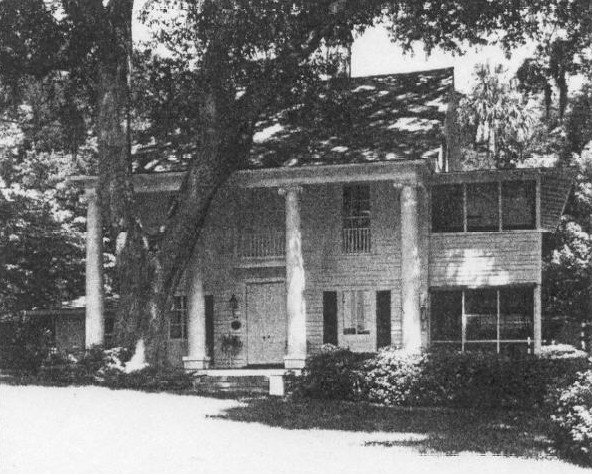
1300 Oak Haven Road, circa 1848
The increasing number of settlers entering
Florida led to further friction with the native Indian population and ultimately
resulted in the Second Seminole Indian War (1835-1842). Under the Treaty
of Moultrie Creek, signed in 1823, the Seminole Indians agreed to abandon
their claims to all Florida lands in exchange for receiving four million
acres of land for a reservation south of Ocala. It was soon apparent, however,
that the arrangement satisfied neither of the parties involved. The Seminoles
found that their new lands did not support agriculture and that the boundaries
of the reservation confined their semi-nomadic life-style. White settlers
were covetous of the Indian lands and wanted unrestricted access to the
interior of the Florida peninsula. Many whites also believed that the Indians
were harboring runaway slaves. Violent clashes ensued. In 1835 federal
troops were sent to Florida to put down the Indian threat and force the
emigration of tribesmen to reservations west of the Mississippi River.
(continued)
The Second Seminole War, which lasted from
1835 to 1842, was a particularly nasty conflict. Bloody engagements ranged
from Jacksonville to the Suwannee River and as far south as Lake Okeechobee.
Frontier settlements were especially vulnerable to Indian raiding parties.
Many plantations were abandoned for a time as settlers withdrew to fortified
areas. Jacksonville flourished during the war. It constituted a primary
staging point for Federal troops and a safe haven for many of the planters
forced to abandon their lands. By January, 1838, much of the organized
resistance of the Indians was broken. The Seminole leader, Chief Osceola,
had been captured the previous autumn and died while incarcerated at Fort
Moultrie in South Carolina. Colonel Zachary Taylor's victory over four
hundred Seminoles at Okeechobee on Christmas day 1837 proved to be the
largest battle of the war. Still, Indian raiding parties continued to prey
upon isolated settlements and peace did not officially come until 1842.
Nearly four thousand Seminoles were sent west to the Indian Territory and
many of the remaining Indians moved south to the Everglades.

1300 Oak Haven Road, circa 1848
About 1837, according to local lore, Richard
hired John H. Sammis to manage the sawmill, introducing to the area an
important figure in the history of Arlington. A native of New York, Sammis
moved to Florida in the 1820s and for a time worked in the employ of Zephaniah
Kingsley, a prominent planter whose holdings at the time were situated
on Fort George Island. Sammis married one of Kingsley's daughters, Mary.
Upon the death of Francis Richard in 1839, Sammis purchased 5500 acres
of Richard's land north of Pottsburg Creek, including the mill site. He
initially established his residence near the mill, north of Strawberry
Creek. Sometime in the 1850s, however, Sammis moved to a large dwelling
atop a bluff north of the Arlington River. Whether this building, located
at 207 Noble Circle West, was built earlier or whether Sammis built it
sometime after 1850 remains conjectural. Local sources believe that the
house dates from before 1838 and was occupied by Oran Baxter, a relative
by marriage to Sammis. The extensive use of circular-saw lumber in the
house suggests, however, that it could not have been built before the 1850s,
when that type of saw was introduced in Duval County.
A letter survives that Francis Richard II
wrote to Sammis in 1837 delivering instructions on managing his enterprises
in Arlington. Richard listed rules for feeding and caring for the workers
at his mill and the prices to be charged for the lumber they produced.
The letter makes it clear that the site harbored a cotton gin. Of particular
interest is a reference to construction of a house for his son, Francis,
III, probably the building which still stands at 1300 Oak Haven Road. Richard
closed the letter with an admonition that Sammis prohibit the workers,
men and women, from "going to Jacksonville often...as they will only learn
vices, and probably no good.''
The location of the first steam-powered circular
saw in northeast Florida was at Hazzard's Bluff (now Empire Point), at
the mouth of Pottsburg Creek, south of the Arlington River. In January
1850 the Barton & Hayward Iron Works Company of Baltimore dispatched
twenty-four year old John Clark to Florida to install the machinery for
the mill. A native of Chester, New Hampshire, Clark learned the trade in
his native state and worked at it in Baltimore. In helping to revolutionize
the Florida lumber industry, Clark contributed mightily to Jacksonville's
ante-bellum explosion of growth. He also installed a mill at Middleburg
before returning to Jacksonville in 1851 to set up his own mill at the
corner of Bay and Water streets. The mill at Empire Point, like Virtually
every other one in the area, was destroyed in the conflict that began in
1861.

John H. Sammis House. circa 1855
continued on jackvil6.htm ...............

